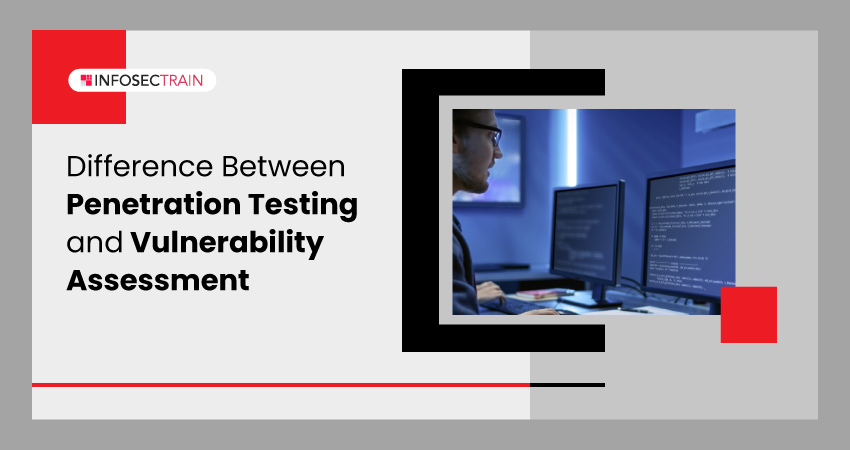Difference Between Penetration Testing and Vulnerability Assessment
Penetration Testing and Vulnerability Assessment are two distinct but related methods used to evaluate the security of IT systems, networks, and applications. While they share some similarities, they have different objectives and approaches. Let us take a closer look at each of them and their differences in this article.

Penetration Testing
Penetration Testing, also known as “Pentesting,” is a systematic and controlled method of assessing the security of IT systems, networks, applications, and other infrastructure components. It involves simulating real-world attacks on these systems to identify vulnerabilities and determine their potential impact.
Vulnerability Assessment
Vulnerability Assessment is all about detecting and evaluating any weaknesses, vulnerabilities, and flaws in IT systems, networks, and applications. It involves scanning and analyzing systems to uncover security gaps, helping organizations understand their risk exposure and prioritize remediation efforts.
Penetration Testing vs. Vulnerability Assessment
Below are the main differences between Penetration Testing and Vulnerability Assessment:
| Basis | Penetration Testing | Vulnerability Assessment |
| Objective | Its objective is to actively exploit vulnerabilities to assess the effectiveness of the security measures and identify potential entry points an attacker could exploit to breach a system. | It aims to identify and quantify system, network, or application vulnerabilities. It focuses on identifying weaknesses and security flaws that could be exploited by attackers. |
| Methodology | It combines automated and manual techniques. It may start with a vulnerability assessment to identify potential weaknesses but then progresses to actively exploiting vulnerabilities through various attack scenarios using ethical hacking techniques. | It often uses automated tools and techniques to scan and analyze systems for known vulnerabilities, misconfigurations, and weak security controls. |
| Analysis | It involves a deeper dive into vulnerabilities. It attempts to exploit identified vulnerabilities and gain access to sensitive information, escalate privileges, or compromise the system to assess the potential impact of an attack. | It provides a broad view of potential vulnerabilities, often with a prioritized list of vulnerabilities based on severity. It does not typically attempt to exploit vulnerabilities or verify their impact. |
| Output | The output of penetration testing is a detailed report that includes the vulnerabilities discovered, the exploited attack vectors, the impact of successful attacks, and recommendations for improving security. | The output of a vulnerability assessment is usually a report that lists the identified vulnerabilities, including their severity ratings and recommendations for remediation. |
| Frequency | It is typically conducted periodically, such as annually, or after significant changes to systems or applications. It is a more resource-intensive process and is often used to validate the effectiveness of security measures after vulnerability assessments. | It can be performed regularly, even on a continuous basis, as part of ongoing security monitoring. It helps organizations identify new vulnerabilities as software and systems are updated or changed. |
Conclusion:
Penetration Testing actively exploits vulnerabilities to evaluate security measures and determine potential attack vectors, while Vulnerability Assessment focuses on identifying weaknesses in a system. Both methods are valuable for assessing the security of an organization’s systems, and they are often used together to provide a comprehensive understanding of security risks and facilitate the development of adequate security measures.
How can InfosecTrain Help?
Enroll in our Certified Ethical Hacker (CEH), Advanced Penetration Testing, and Red Team Expert training courses to learn more about penetration testing and vulnerability assessments. These courses provide comprehensive and in-depth knowledge of ethical hacking techniques, advanced penetration testing methodologies, and vulnerability assessment tools.

TRAINING CALENDAR of Upcoming Batches For CEH v13
| Start Date | End Date | Start - End Time | Batch Type | Training Mode | Batch Status | |
|---|---|---|---|---|---|---|
| 11-May-2025 | 28-Jun-2025 | 09:00 - 13:00 IST | Weekend | Online | [ Close ] | |
| 31-May-2025 | 06-Jul-2025 | 19:00 - 23:00 IST | Weekend | Online | [ Open ] | |
| 07-Jun-2025 | 13-Jul-2025 | 09:00 - 13:00 IST | Weekend | Online | [ Open ] | |
| 21-Jun-2025 | 27-Jul-2025 | 19:00 - 23:00 IST | Weekend | Online | [ Open ] | |
| 06-Jul-2025 | 16-Aug-2025 | 09:00 - 23:00 IST | Weekend | Online | [ Open ] |
Our training program offers hands-on exercises with simulated targets, providing practical experience in performing Penetration Testing and Vulnerability Assessments. Participants will gain skills using various tools, developing expertise in identifying vulnerabilities, exploiting them, and assessing security controls. This practical approach enhances participants’ understanding and proficiency in real-life scenarios.
TRAINING CALENDAR of Upcoming Batches For APT with KALI Linux
| Start Date | End Date | Start - End Time | Batch Type | Training Mode | Batch Status | |
|---|---|---|---|---|---|---|
| 24-May-2025 | 29-Jun-2025 | 09:00 - 13:00 IST | Weekend | Online | [ Open ] | |
| 26-Jul-2025 | 31-Aug-2025 | 09:00 - 13:00 IST | Weekend | Online | [ Open ] |
You can also enroll in our Pentester Combo training course.
Check Other Blogs
Top Penetration Testing Trends To Follow
Difference Between Internal And External Penetration Testing
Bug Bounty Vs. Penetration Testing
Using The Metasploit Framework For Penetration Testing
What Is Penetration Testing?







 1800-843-7890 (India)
1800-843-7890 (India)